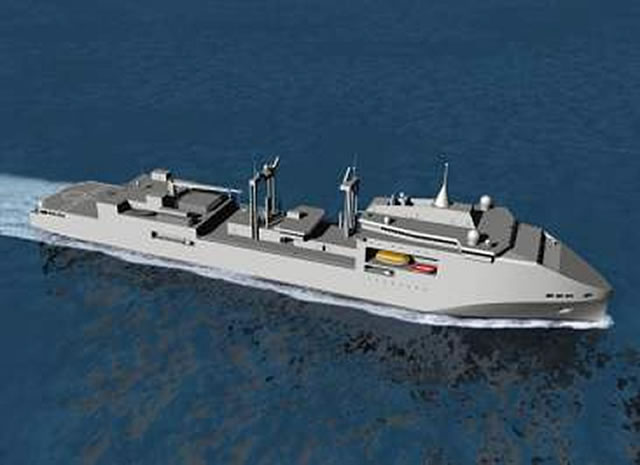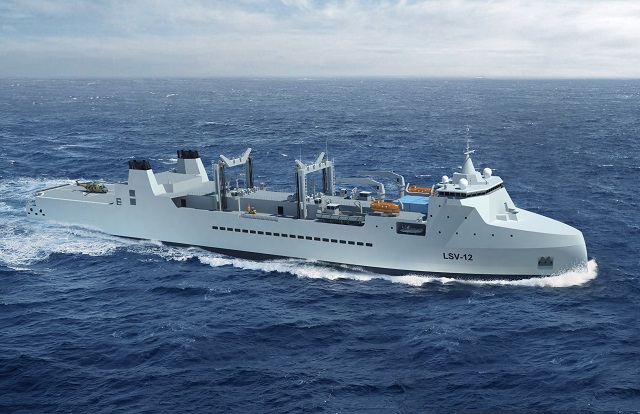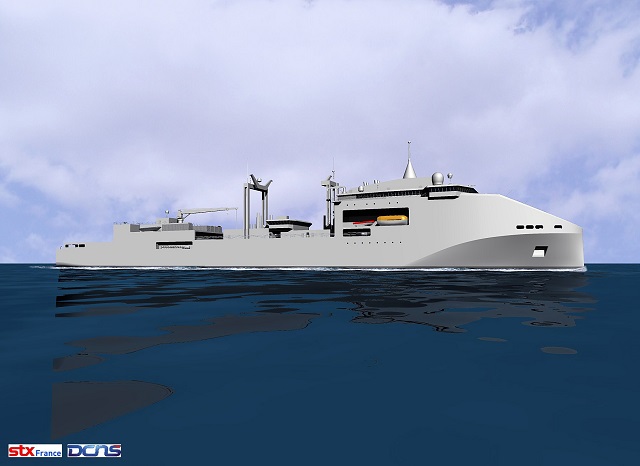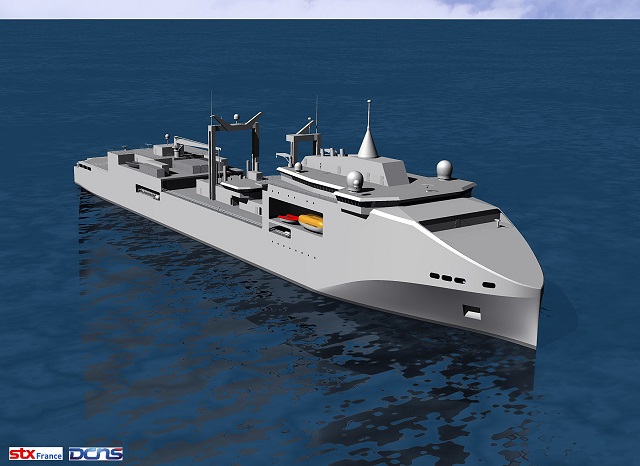| |
|||
| a | |||
Focus
- DCNS Brave Replenishment Tanker |
|||
Exclusive:
DCNS Working on Electric Propulsion Variant of the BRAVE Replenishment
Tanker |
|||
Navy
Recognition learned that DCNS and its partner STX France recently
received a risk assessment contract from the French procurement agency
(DGA) to study a fully electric variant of its BRAVE replenishment tanker
design. Unveiled
at Euronaval 2010, DCNS updated the design of the BRAVE support
ship for Euronaval
2012. BRAVE served as the basis for the study contract won by DCNS and STX in 2012 as part of the future FLOTLOG program which aims at replacing the Durance class auxiliary/replenishment vessels in the French Navy. |
|||
 BRAVE
replenishment tanker in electric propulsion configuration. Exclusive
image: DCNS BRAVE
replenishment tanker in electric propulsion configuration. Exclusive
image: DCNS |
|||
With an innovative design that incorporates the latest advances in naval
architecture, the BRAVE energy balance is lower than 15-20% compared
to traditional platforms. BRAVE type vessels are operationally more
efficient thanks to a new concept which minimizes the duration of underway
replenishment at sea (UNREP)., UNREPs are often considered as a vulnerable
phase for warships. The preparation of replenishment operations and
their implementation in real time has been optimized in order to superimpose
without clogging the flow of products, on and between the ships. With
four liquid transfer masts and two masts for heavy loads, BRAVE has
a hangar for two helicopters and a wide platform to organize vertical
replenishment (VERTREP), with the capability to accommodate 35 tons
class helicopters. At quay, two cranes may be used for handling containers
and reloading frigates and submarines with missiles and weapons. |
 BRAVE replenishment tanker in classic (mechanical) propulsion. Image: DCNS |
||||
Electric
propulsion BRAVE BRAVE served as the basis for the study contract won by DCNS and STX in 2012 as part of the future FLOTLOG program. For this purpose, a new version has been proposed with an electric propulsion. This new design allows to place the diesel generators at the front of the vessel and dedicate the stern area to electric propulsion engines. In this way, the civil and military functions are better separated. The central part of the vessel being dedicated exclusively to the transport of liquid and inert cargoes and the ammunition being stored at the stern. In addition, with this architecture allows for the removal of exhaust chimneys above the hangar and improves the horizontal flow of dry cargo. Finally, Navy Recognition believes an electric propulsion BRAVE would have some major economical benefits over the mechanical variant throughout the life cycle of the vessel. According to Hervé Boy, Surface Ship Marketing Manager at DCNS, two versions of BRAVE (mechanical propulsion and electric propulsion) are being studied to answer the needs of both the French Navy and foreign customers. Mr Boy added: "The electric version is quite interesting in terms of future evolution. For example if you want to protect these vessels: The next generation of weapons will probably be based on electric energy. Lasers for example are very electric energy demanding and an electric propulsion technology could be the answer". |
||||
 BRAVE replenishment tanker in electric propulsion configuration. It is fitted with a very large panoramic bridge. Exclusive image: DCNS |
||||
Available
in several models, from 180 to 205 meters, BRAVE was designed to minimize
risks: Aboard this double-hulled ship, ammunition and fuel are stored
in distinct spaces, protected from each other and away from the crew living
quarters. The cargo capacity range from 8000 to 16,000 m3 of fuel (6 to
9 tanks), 1500 m3 of fresh water (2 tanks), 2000 tons of cargo and 30x
20-foot containers on 2700 sqm and 300 tonnes of ammunition in 4 tanks
spread over a total area of 700 sqm. Several workshops are placed at the rear of the vessel over 300 m², allowing to make repairs and maintenance work. An area of 1000 m² can accommodate cargo and vehicles (which may be rolled on/rolled off through a side door). The vessel can also be equipped with a stern door, near the waterline, giving a capability to interact with landing craft. BRAVE can therefore ensure logistical support of military bases or support points, or intervene in a humanitarian operation, even if no port infrastructure is available. It is also fitted with an onboard hospital with 30 to 60 beds and can accommodate 100 passengers in addition to its 100 crew complement. |
||||
 Based on the illustration, the BRAVE replenishment tanker in electric propulsion configuration may be fitted with a Nexter Narwhal 20mm RWS at the bow and MBDA Simbad-RC missile defense system at the stern. The defense system is modular and its final configuration depends on customer needs. Exclusive image: DCNS |
||||
Specifications . |
||||
BRAVE 200
Mechanical Propulsion Dimensions: 195 m x 28 m Displacement: ~ 30,000 t Speed: > 19 knots Crew : ~ 100 |
BRAVE 200 Electric
Propulsion Dimensions: 198 m * 28,5 m Displacement: ~ 33,000 t Speed: > 20 knots Crew : ~ 125 |
|||
. According to DCNS, BRAVE vessels are fleet efficiency multiplier. They represent the perfect balance between the different logistic functions and their design is easily adaptable to customer needs. |
||||










